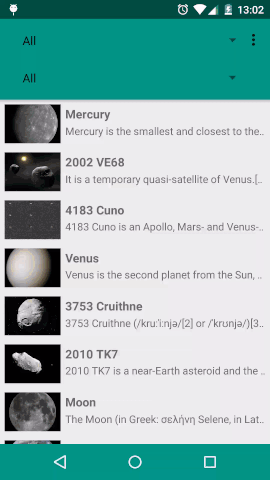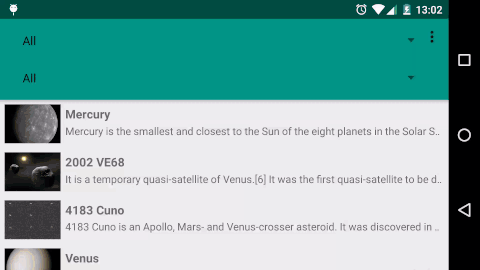MaterialToolbar 
MaterialToolbar makes it easy to build a Fragment navigation based application with fully customized toolbar views.
Example
First thing you got to do is to set Theme.AppCompat.Light.NoActionBar in your AndroidManifest.xml file, and insert your MaterialToolbar instead of standard Toolbar in your activity xml layout. The layout also must to include a fragment container view such as this FrameLayout in which fragments will be placed
<LinearLayout xmlns:android="http://schemas.android.com/apk/res/android"
xmlns:tools="http://schemas.android.com/tools"
android:layout_width="match_parent"
android:layout_height="match_parent"
android:orientation="vertical"
tools:context=".MainActivity">
<es.shyri.materialtoolbar.MaterialToolbar
android:id="@+id/main_toolbar"
android:layout_width="match_parent"
android:layout_height="wrap_content"
android:animateLayoutChanges="true"
android:background="?attr/colorPrimary"
android:minHeight="?attr/actionBarSize" />
<FrameLayout
android:id="@+id/fragmentContainer"
android:layout_width="match_parent"
android:layout_height="match_parent"
android:animateLayoutChanges="true" /> </LinearLayout> Note that I set the animateLayoutChanges flag in order to have smooth toolbar transitions.
After that you can override the onCreate method of the activity and attach the activity instance to the presenter. You have to provide also the layout id of the MaterialToolbar and the fragment container.
@Override
protected void onCreate(Bundle savedInstanceState) {
super.onCreate(savedInstanceState);
setContentView(R.layout.activity_main);
presenter = MaterialPresenter.getInstance();
// get the instance of our presenter
// ATTACH the activity to the presenter telling it the id of the MaterialToolbar and the view holding the Fragments
presenter.attachActivity(this, R.id.main_toolbar, R.id.fragmentContainer);
// Only if the fragment container has no fragment, we tell the MaterialPresenter to navigate to a new Fragment instance
// This will assure the right behaviour during screen rotation and other configuration changes
if (getFragmentManager().findFragmentById(R.id.fragmentContainer) == null) {
presenter.navigateTo(new MyAwesomeFragment());
}
}
Also for roation, other configuration changes and to avoid view leaks it is necessary to detach the activity from the presenter overriding the onDestroy() method
@Override
protected void onDestroy() {
super.onDestroy();
presenter.detachActivity();
}
Finally we want to override the onBackPressed method to let the presenter handle the fragment backstack poping
@Override
public void onBackPressed(){
if(!presenter.onBackPressed()) super.onBackPressed();
}
You have to implement MaterialToolbarSupplier only in the fragments that will provide custom Toolbar layout. In the onCreateView method you must inflate the MaterialToolbarContent providing a layout. Note you can have different layouts, for example one for portrait and other for landscape. Here you can also instantiate views of your MaterialToolbarContent
public class MyAwesomeFragment extends Fragment implements MaterialToolbarSupplier {
@Override
public View onCreateView(LayoutInflater inflater, ViewGroup container, Bundle savedInstanceState) {
// [...] infalte your fragment view
// This is your time to create your MaterialToolbarContent and instantiate the views.
toolbarContent = new MaterialToolbarContent(getActivity(), R.layout.my_awesome_toolbar);
// Tell the presenter to set the MaterialToolbarContent of this Fragment.
presenter.getToolbar().setContent(toolbarContent);
// Instantiate all views
Button myAwesomeButton = toolbarContent.findViewById(R.id.myAwesomeButton);
myAwesomeButton.findViewById(R.id.myAwesomeButton).setOnClickListener(new View.OnClickListener() {
@Override
public void onClick(View v) {
presenter.navigateTo(new OtherFragment());
// We can use the presenter this Fragment to navigate to others.
}
}
);
// [...]
return view;
}
}
And also override the other MaterialToolbarSupplier methods, just one to get the presenter and other to return the MaterialToolbar to the presenter
@Override
public void setPresenter(MaterialPresenter presenter) {
// get the presenter instance, you can use it later for navigate to children Fragments.
this.presenter = presenter;
}
@Override
public MaterialToolbarContent getToolbarContent() {
// This will allow the presenter to set the MaterialToolbarContent when user navigates back to
// this Fragment or during configuration changes
return toolbarContent;
}
Download
MaterialToolbar is available through jcenter()
dependencies {
compile 'es.shyri:materialtoolbar:0.1.1'
}
License
Copyright 2015 Shyri Villar Licensed under the Apache License, Version 2.0 (the "License");
you may not use this file except in compliance with the License. You may obtain a copy of the License at
http://www.apache.org/licenses/LICENSE-2.0 Unless required by applicable law or agreed to in writing, software distributed under the License is distributed on an "AS IS" BASIS, WITHOUT WARRANTIES OR CONDITIONS OF ANY KIND, either express or implied. See the License for the specific language governing permissions and limitations under the License. 
